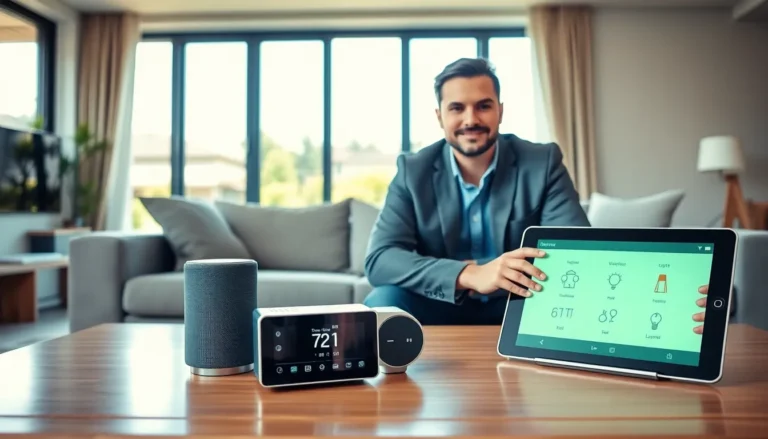Table of Contents
ToggleImagine a world where your coffee brews itself, your thermostat learns your schedule, and your fridge reminds you when you’re out of milk. Sounds like the plot of a sci-fi movie, right? Welcome to the era of smart gadgets. These little wonders are not only changing the way we live but also simplifying our daily routines in ways we never thought possible. If you’re curious about how smart gadgets are stepping up their game, this article is here to guide you through their various types, benefits, and challenges. So sit back, relax, and let’s jump into the intriguing realm of smart technology.
What Are Smart Gadgets?

Smart gadgets, at their core, are devices equipped with internet connectivity, allowing them to communicate with other devices, collect data, and even learn from user behavior. Think of them as your helpful sidekicks in navigating modern life. From smart speakers like Amazon Echo to wearable fitness trackers, these gadgets use advanced technology, including artificial intelligence (AI) and the Internet of Things (IoT), to make everyday tasks easier and more efficient.
Most importantly, the term “smart” refers to the ability of these gadgets to adapt to your preferences. They don’t just perform tasks: they learn from your habits. For instance, a smart thermostat can analyze your daily patterns, adjust the temperature according to your schedule, and help save energy, which both benefits the planet and your wallet.
Types of Smart Gadgets
Smart gadgets come in various forms, each designed to enhance a specific aspect of life. Here are some categories worth exploring:
1. Smart Home Devices
These include smart speakers, lighting systems, and security cameras, all designed to make your home more secure and convenient. For example, Philips Hue lights can be programmed to change color or brightness according to your mood or time of day, all controllable from your smartphone.
2. Wearable Technologies
Fitness trackers and smartwatches fall into this category. Gadgets like the Fitbit or Apple Watch monitor heart rate, steps, and even sleep patterns. These devices aim to keep users informed about their health while providing motivating feedback.
3. Smart Kitchen Appliances
Imagine a fridge that can create grocery lists or an oven that preheats itself while you’re on the way home. Smart kitchen gadgets, such as the Instant Pot or smart coffee makers, are revolutionizing cooking and meal prep.
4. Smart Health Devices
From smart scales to home diagnostic tools, these gadgets provide insights into personal health metrics. Devices like the Withings Body+ scale can sync with mobile apps to enhance health tracking.
5. Smart Entertainment Devices
These include smart TVs and streaming devices that personalize viewing experiences. Streaming services like Netflix offer tailored recommendations based on your viewing history, thanks to smart technology.
Benefits of Using Smart Gadgets
One can’t overlook the numerous benefits smart gadgets bring to our lives:
1. Convenience
Smart gadgets save time by automating daily tasks. For instance, a robot vacuum like the Roomba takes care of cleaning floors without any human intervention.
2. Energy Efficiency
Many smart gadgets offer energy-saving features through remote controls and sensors. A smart thermostat can reduce heating and cooling costs significantly.
3. Enhanced Security
With smart home security devices, you can monitor your home remotely. Smart cameras can send alerts when they detect movement, enhancing peace of mind.
4. Personalization
Thanks to their learning capabilities, smart gadgets personalize experiences. Your favorite music playlists or meal suggestions can be readily available, tailored to your tastes.
5. Health Improvements
From tracking steps to keeping tabs on health metrics, smart gadgets encourage healthier living. They provide insights that can motivate users to stay active and make informed decisions.
Challenges and Considerations
While smart gadgets promise numerous advantages, they also come with challenges:
1. Security Risks
Connected devices can be vulnerable to cyber-attacks. Proper security measures, such as strong passwords and regular software updates, are crucial in safeguarding personal information.
2. Compatibility Issues
Not all smart gadgets are created equal. Some may not be compatible with others, leading to frustrating experiences. It’s essential to check for platform compatibility before making purchases.
3. Dependence on Technology
Relying too heavily on smart gadgets can create problems when technology fails. If your smart home hub goes offline, you might find yourself struggling with basic tasks that were once automated.
4. High Initial Costs
Although many smart devices can save money in the long run, the initial investment can be steep. Finding the right balance between necessity and luxury is vital.
Future Trends in Smart Gadgets
The landscape of smart gadgets is continually evolving. Here’s what to expect in the near future:
1. Integration and Interoperability
Expect more devices that communicate seamlessly with one another. This will enhance user experience, allowing for cohesive smart homes.
2. AI-Powered Gadgets
Artificial intelligence will become even smarter, predicting users’ needs and preferences more accurately. Imagine a refrigerator that suggests recipes based on what’s inside.
3. Health Monitoring Innovations
As health awareness increases, smart gadgets will likely evolve to incorporate more advanced health monitoring features. From glucose monitoring to sleep tracking, the potential is vast.
4. Sustainability
Future smart gadgets will also focus on being environmentally friendly. Devices that reduce energy consumption or that are made from sustainable materials will likely see increased demand.




